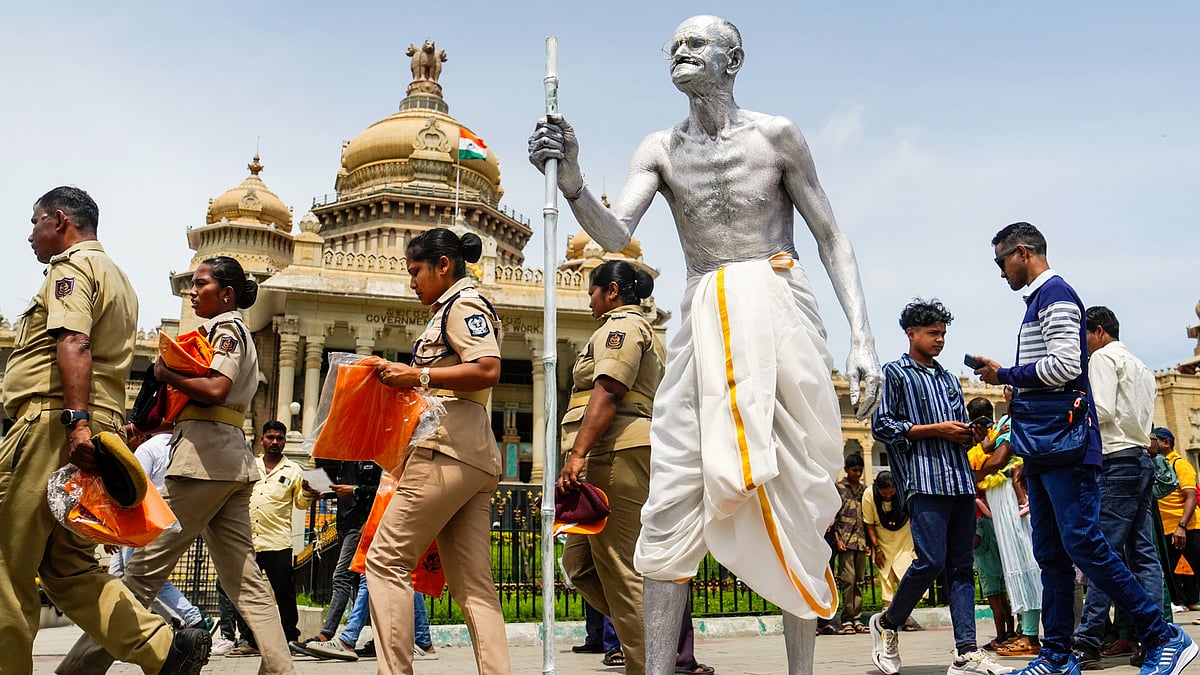Opinion
The idea, and the fear, of Swaraj
Why is Gandhi's dream of Swaraj still so threatening? Because it unsettles those who never wished to free the masses from bondage

An organisation has just marked a hundred years of existence, celebrating its centenary with great pomp. Conveniently, it is their ideological heirs who hold political power today. But no matter how much they try to polish their image, memories remain.
Memories of a time when this organisation would not accept the tricolour. When the Constitution was rejected. When the idea of a Dalit thinker chairing the committee that drafted the Constitution was an insult to their worldview. Ironically, the group was born on Vijayadashami — the very day Babasaheb Ambedkar embraced Buddhism.
This outfit has always insisted on its own brand of nationalism. Its founder argued that a nation could not be built from different civilisational and religious streams. Just as Hitler in Germany could not tolerate Jews and Germans living together, this ideology too declared that only those who spoke languages derived from Sanskrit truly belonged. Their devotion was to the “fatherland”, with little room for the motherland — or any idea that carried a feminine principle.
From such thinking emerged an atmosphere where the living embodiment of Swaraj was extinguished in flesh, but not in spirit. His spectacles are paraded today as a symbol for cleanliness drives, while his vision is twisted beyond recognition. On social media, the so-called 'fringe' depicts him as a demon king to be pierced by arrows. Children are made to clap at school skits recreating the three bullets that cut him down. Statues are raised of his assassin.
And yet, Mahatma Gandhi remains immortal. Across the world, his non-violent experiments have been invoked to resist racial supremacy, political slavery, and economic exploitation. Humanity has moved forward, beyond bitterness, carrying him along. His path does not depend on India’s patronage. Like the Buddhist path, it has scattered disciples across the globe, even if we at home pretend to forget.
Published: undefined
What is it, then, that troubles them about him? He was seventy-eight; his death was inevitable. Why, then, is his dream of Swaraj still so threatening? Because it unsettles those who never wished to free the masses from bondage.
He taught farmers, workers, and women to ask questions, to rise, to organise. He defined Swaraj not as mere political freedom, but as equal distribution of resources, the annihilation of caste, gender justice. How could those who thrived on social arrogance accept such a vision?
They struck at him when he campaigned against untouchability. His idea of 'Ram Rajya' was not myth but practice — at Sabarmati Ashram, where he entrusted the kitchen to a Dalit family. When others walked out in protest, he told them calmly: “You are free to go. You may stop helping me. Even if only I and this family remain, the decision will stand.” This firmness is called Gandhi. It was not weakness, but strength.
It is Swaraj that terrifies them still. For Swaraj refuses to bow to unjust policies, false pride, or enslaving systems. He wanted not just independence, but Swaraj — the freedom for ordinary citizens to hold even elected governments to account through satyagraha.
Our rulers today busy themselves with mere nomenclature, tinkering with names and symbols. But where is justice, when countless farmers are branded traitors for protesting? When Sonam Wangchuk is labelled an agent of a hostile state? These are struggles for truth, not betrayals.
Swaraj is not about token representation. It is about equal participation. The entry of an Adivasi, a Dalit, a minority into power is only a beginning; the real question is whether caste hierarchy itself has been challenged. Without that, it is simply installing obedient placeholders.
Published: undefined
Swaraj leaves no room for fear. It keeps doors and windows open to lofty ideas. It remains rooted without becoming rigid. A politics built on fear, by contrast, draws lines of “us” and “them”, manufactures narratives, and makes power easier to seize. But in such an atmosphere, love, fraternity, justice, and rights cannot survive.
This year, Gandhi Jayanti coincides with Vijayadashami. Perhaps it is coincidence, perhaps the wheel of time. But why would a man who breathed his last with the name of Ram imagine 'Ram Rajya'? Consider: in the Ramayana, golden kingdoms of fear and accumulation are always challenged. Sita was discovered by a plough-wielding king, not by a tycoon with a Rs 6,000-crore wedding. Ram’s foreign policy was not used to expand the empire of a favoured industrialist. His allies were Sugriva and the vanaras.
The Ramayana never glorifies Ayodhya’s wealth. When Ram chases the golden deer, he loses his freedom, is trapped, and must struggle anew. The only description of Ram Rajya worth recalling is this: in Ayodhya, no one locked their doors. Hearts were open; fear did not exist. When narrowness crept in, labour collapsed.
The story tells us: Swaraj requires daily vigilance. It is subtle, never static. A moment’s lapse, and one slides back into slavery.
In a hundred years, the organisation has trimmed its slogans, polished its words. But its language of power remains the same. There is no Swaraj here — only 'Suraj', rule by the dominant, cloaked in noble names.
Gandhi's path, however, remains untouched. It will continue to illuminate humanity.
📌Reference: We or Our Nationhood Defined, M.S. Golwalkar, pp. 83–98 (original edition)
Translated from Hindi
Published: undefined
Follow us on: Facebook, Twitter, Google News, Instagram
Join our official telegram channel (@nationalherald) and stay updated with the latest headlines
Published: undefined